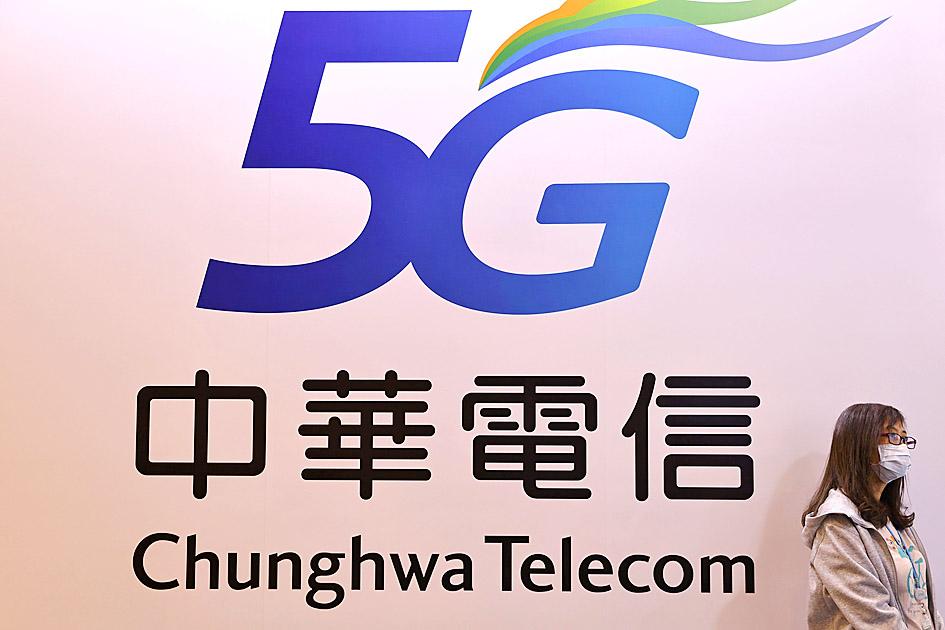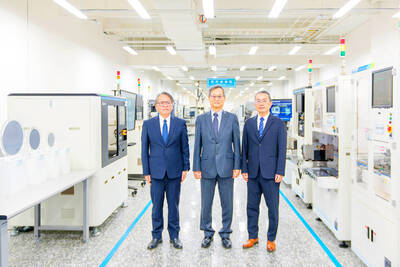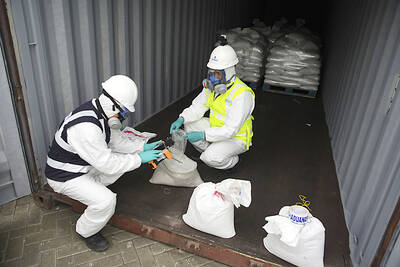Chunghwa Telecom Co (中華電信), the nation’s biggest telecom service provider, on Monday reported that net profit last year increased 1.9 percent following the debut of 5G services, its first annual growth since 2015.
Net profit expanded to NT$33.42 billion (US$1.17 billion), up from NT$32.79 billion in 2019, and surpassed the company’s forecast of NT$30.91 billion to NT$32.47 billion.
That translated into earnings per share of NT$4.31, up from NT$4.23 in 2019.

Photo: Ann Wang, Reuters
Revenue last year remained little changed at NT$207.61 billion, up from NT$207.52 billion in 2019, but falling short of the company’s guidance of NT$214.1 billion to NT$215.29 billion.
Revenue from corporate customers, value-added services and handset sales offset a continual decline in revenue from voice calls, mobile services and roaming services, the company said, adding that 5G services gradually boosted its average revenue per user (ARPU).
Taiwan Mobile Co’s (台灣大) net profit last year fell 9.54 percent to NT$11.29 billion, down from NT$12.48 billion in 2019, due to 5G spectrum amortization and spending on 5G infrastructure.
That translated into earnings per share of NT$4.01, down from NT$4.51 in 2019, the company said.
Last year’s profit was better than the firm’s forecast of NT$9.47 billion, or earnings per share of NT$3.96.
By the end of last year, Taiwan Mobile had 400,000 5G subscribers, it said, adding that the higher tariffs helped slow a decline in mobile service revenue.
For the whole of last year, its postpaid ARPU fell to NT$657 from NT$722 in 2019, the firm said.
Taiwan Mobile’s revenue increased 6.78 percent to NT$132.86 billion, from NT$124.42 billion in 2019, thanks to a greater contribution from its e-commerce subsidiary Momo.com Inc (富邦媒體). More than half of Taiwan Mobile’s revenue came from Momo.com, which saw revenue soar about 30 percent to NT$67.2 billion last year from NT$51.83 billion in 2019.
However, Taiwan Mobile’s revenue fell below its guidance of NT$134.53 billion.
Far EasTone Telecommunications Co’s (遠傳電信) net profit last year fell 4.24 percent to NT$8.35 billion — beating its guidance of NT$8.02 billion — from NT$8.72 billion in 2019.
That translated into earnings per share of NT$2.56, down from NT$2.68 in 2019, the company said.
Revenue fell 5.21 percent to NT$79.5 billion from NT$83.87 billion in 2019 — missing the company’s guidance of NT$86.76 billion — despite annual growth of 13 percent from new services, including information and communications technology solutions, cloud-based programs and Internet-of-Things services.

SMART MANUFACTURING: The company aims to have its production close to the market end, but attracting investment is still a challenge, the firm’s president said Delta Electronics Inc (台達電) yesterday said its long-term global production plan would stay unchanged amid geopolitical and tariff policy uncertainties, citing its diversified global deployment. With operations in Taiwan, Thailand, China, India, Europe and the US, Delta follows a “produce at the market end” strategy and bases its production on customer demand, with major site plans unchanged, Delta president Simon Chang (張訓海) said on the sidelines of a company event yesterday. Thailand would remain Delta’s second headquarters, as stated in its first-quarter earnings conference, with its plant there adopting a full smart manufacturing system, Chang said. Thailand is the firm’s second-largest overseas

‘REMARKABLE SHOWING’: The economy likely grew 5 percent in the first half of the year, although it would likely taper off significantly, TIER economist Gordon Sun said The Taiwan Institute of Economic Research (TIER) yesterday raised Taiwan’s GDP growth forecast for this year to 3.02 percent, citing robust export-driven expansion in the first half that is likely to give way to a notable slowdown later in the year as the front-loading of global shipments fades. The revised projection marks an upward adjustment of 0.11 percentage points from April’s estimate, driven by a surge in exports and corporate inventory buildup ahead of possible US tariff hikes, TIER economist Gordon Sun (孫明德) told a news conference in Taipei. Taiwan’s economy likely grew more than 5 percent in the first six months

SUPPLY RESILIENCE: The extra expense would be worth it, as the US firm is diversifying chip sourcing to avert disruptions similar to the one during the pandemic, the CEO said Advanced Micro Devices Inc (AMD) chief executive officer Lisa Su (蘇姿丰) on Wednesday said that the chips her company gets from supplier Taiwan Semiconductor Manufacturing Co (TSMC, 台積電) would cost more when they are produced in TSMC’s Arizona facilities. Compared with similar parts from factories in Taiwan, the US chips would be “more than 5 percent, but less than 20 percent” in terms of higher costs, she said at an artificial intelligence (AI) event in Washington. AMD expects its first chips from TSMC’s Arizona facilities by the end of the year, Su said. The extra expense is worth it, because the company is

The seizure of one of the largest known mercury shipments in history, moving from mines in Mexico to illegal Amazon gold mining zones, exposes the wide use of the toxic metal in the rainforest, according to authorities. Peru’s customs agency, SUNAT, found 4 tonnes of illegal mercury in Lima’s port district of Callao, according to a report by the non-profit Environmental Investigations Agency (EIA). “This SUNAT intervention has prevented this chemical from having a serious impact on people’s health and the environment, as can be seen in several areas of the country devastated by the illegal use of mercury and illicit activities,”